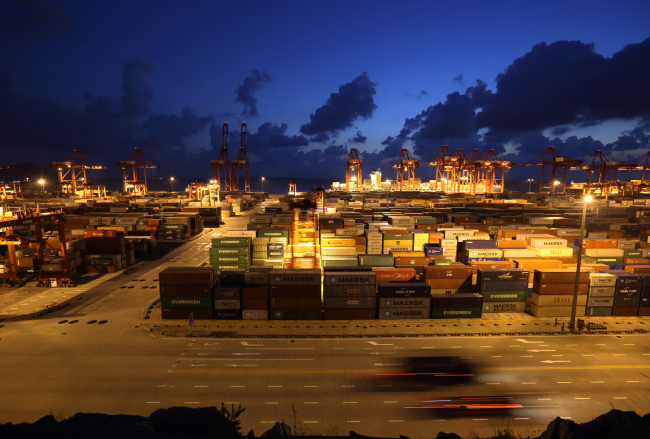World Bank trims developing East Asia growth forecast
By Korea HeraldPublished : Oct. 6, 2014 - 20:37
The World Bank lowered its forecasts for growth in developing East Asia this year and next as China’s expansion moderates and policy makers brace for tighter global monetary conditions.
The region is forecast to grow 6.9 percent in 2014 and 2015, down from 7.1 percent projected in April, the Washington-based lender said in its East Asia and Pacific Economic Update released Monday. China will expand 7.4 percent this year and 7.2 percent next year, compared with 7.6 percent and 7.5 percent previously forecast, the report showed.
Data released last month showed China’s industrial-output expansion at its weakest since the global financial crisis, while moderating investment and retail sales growth underscore the risks of a deepening economic slowdown led by a slumping property market. Significant uncertainties remain that could affect the region’s growth including downside risks in the euro area and Japan, a sharp tightening in global financial conditions and international and regional geopolitical tensions, the World Bank said.
The region is forecast to grow 6.9 percent in 2014 and 2015, down from 7.1 percent projected in April, the Washington-based lender said in its East Asia and Pacific Economic Update released Monday. China will expand 7.4 percent this year and 7.2 percent next year, compared with 7.6 percent and 7.5 percent previously forecast, the report showed.
Data released last month showed China’s industrial-output expansion at its weakest since the global financial crisis, while moderating investment and retail sales growth underscore the risks of a deepening economic slowdown led by a slumping property market. Significant uncertainties remain that could affect the region’s growth including downside risks in the euro area and Japan, a sharp tightening in global financial conditions and international and regional geopolitical tensions, the World Bank said.

“The best way for countries in the region to deal with these risks is to address vulnerabilities caused by past financial and fiscal policies, and complement these measures with structural reforms to enhance export competitiveness,” Sudhir Shetty, the World Bank’s East Asia and Pacific chief economist, said in a statement.
Growth in the region excluding China is expected to accelerate to 5.3 percent in 2015 from 4.8 percent this year as a gradual recovery in high-income economies boosts demand for its exports, and domestic economic reforms advance in the large Southeast Asian economies, the World Bank said.
It raised its forecast for Malaysia’s 2014 growth to 5.7 percent from 4.9 percent in April because of robust exports in the first half, it said. The surge in shipments helped growth in the economy unexpectedly accelerate to the fastest pace in six quarters in the three months through June from a year earlier.
China’s growth is expected to slow as the government implements policies to address financial vulnerabilities and structural constraints, the World Bank said. As it seeks to strike a balance between containing risks and meeting growth targets, structural reforms in sectors previously reserved for state enterprises and services could help offset the impact of measures to contain local government debt and curb shadow banking, the report showed.
The world’s second-biggest economy was the top trading partner for the 10-member Association of Southeast Asian Nation’s last year, according to data from the Asean-China Centre.
The World Bank also cut its forecasts for Thailand’s growth this year to 1.5 percent from an earlier estimate of 3 percent. The country’s junta, which seized power about four months ago in a coup, has said it will stop buying farm products directly from growers as state purchases spur overproduction, distort the market and create stockpiles.
The country needs to pursue further fiscal reforms following the scrapping of the rice-pledging scheme and proposals including the revision of property income taxes warrant serious consideration by the new government, the World Bank said.
The global economy is showing signs of recovery, albeit at an uneven pace, while significant uncertainties remain regarding the strength and sustainability of the recovery in high-income economies and about the timing of policy actions by central banks in these countries, the World Bank said.
The world’s growth is forecast to be 2.6 percent growth in 2014, and an average of 3.3 percent from 2015 to 2017, it said.
“In this uncertain global environment, there is still a window of opportunity to enact critical, and in some cases overdue, reforms,” the World Bank said in its report. “The short-term priority in several countries is to address the vulnerabilities and inefficiencies that have been created by an extended period of loose financial conditions and fiscal stimulus.” (Bloomberg)
-
Articles by Korea Herald



![[Weekender] Geeks have never been so chic in Korea](http://res.heraldm.com/phpwas/restmb_idxmake.php?idx=644&simg=/content/image/2024/05/16/20240516050845_0.jpg&u=)


![[News Focus] Mystery deepens after hundreds of cat deaths in S. Korea](http://res.heraldm.com/phpwas/restmb_idxmake.php?idx=644&simg=/content/image/2024/05/17/20240517050800_0.jpg&u=)
![[Herald Interview] Byun Yo-han's 'unlikable' character is result of calculated acting](http://res.heraldm.com/phpwas/restmb_idxmake.php?idx=644&simg=/content/image/2024/05/16/20240516050855_0.jpg&u=)











